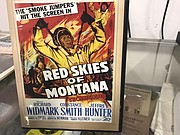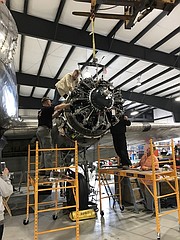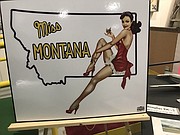Big, beautiful Gooney Bird
By SYD ALBRIGHT
Press Correspondent
Sitting for years in a Missoula museum, a Douglas DC-3 airplane with the nondescript serial number NC24320 will be completely restored and flying to England and Europe to commemorate the D-Day Allied Forces landing at the beaches of Normandy on June 6, 1944.
Built in 1944 and now called “Miss Montana,” NC24320 wasn’t at Normandy in those days.
But in late May, she’ll join 30 other Douglas DC-3 aircraft and hundreds of parachutists from the U.S., Canada, Europe and Australia.
Seven Montana parachutists will board Miss Montana in England and jump out over Normandy, just like thousands of Allied paratroopers did liberating Europe from the Nazis.
Then they’ll fly to Germany to re-enact the Berlin Airlift of 1948-49 that defeated the Soviet blockade of the city.
Nearly a half-million dollars has been spent reconditioning Miss Montana — now sporting a beautiful girl painted on the nose, like so many planes did during that war.
The two Pratt & Whitney R-1830 Twin Wasp engines have been completely rebuilt by Anderson Aeromotive Inc. in Grangeville, Idaho. It’s the only company in America that could do the job.
Popularly called “Gooney Birds,” the DC-3s are also called “Skytrains” and “Dakotas.” The military calls them “C-47s.”
On D-Day 1944, 160,000 American, British and Canadian troops stormed the Normandy beaches, while more than 800 C-47s delivered 24,000 troops behind enemy lines — parachuting from planes or jumping out of gliders they were towing after being cut loose and crash-landing.
VIVID IMAGES
Who can forget the photo of the parachute draped over the church roof at Sainte-Mère-Église, where wounded paratrooper John Steele of Fayetteville, N.C., hanged for two hours, pretending he was dead when he parachuted and was shot by Germans on the way down?
He was eventually captured and interned in a POW camp, but escaped and rejoined his division to fight another day.
French civilians were jubilant as they watched thousands of soldiers leap from the planes, their parachutes filling the skies like giant mushrooms.
Casualties were high among the glider troops from their lightly constructed gliders falling apart or flipping over after hitting trees or other obstacles upon landing.
The Allies suffered 209,000 casualties at Normandy — the Germans 200,000, with another 200,000 troops captured.
To start this year’s re-enactments, the American planes will rally at Cambridge, Conn., and then head across the Atlantic on May 19. They’ll fly loose formation to Duxford Airfield in England, with refueling stops between.
Three Air National Guard C-130s will patrol with them in case of emergency.
Between June 5 and 9, the planes will take off from Duxford, then fly across the English Channel and re-enact the D-Day paratroop jump in Normandy.
Then it’s on to Germany to re-enact the Cold War’s Berlin Airlift.
Organizers say the event is unlikely to ever be duplicated again.
At the controls of Miss Montana for the flight to Europe will be award-winning actor Treat Williams, who has owned several airplanes and holds a commercial pilot’s license.
Also on board will be pilot Eric Komberec and pilot Bryan Douglas, both from Missoula, and mechanics Randy and Crystal Schonemann of Crystal, Idaho. Eric Komberec is the nephew of Tim Komberec, president of Empire Airlines, based at the Coeur d’Alene Airport.
Airplanes are a lot like people: They experience rough weather from time to time, they wear out and need fixing, and live through times of glory and tragedy. And eventually they are gone, and sometimes remembered for what they did.
Miss Montana — long before she had that name — will always be remembered for being part of one of the great natural disasters in Montana History: The Mann Gulch Fire of August 1949.
TIED TO TRAGEDY
According to historical writings, it was 97 degrees hot and windy in Mann Gulch 24 miles north of Helena on that day, when a lightning strike sparked a fire. Montana State University student James O. Harrison, working as a forest ranger that summer, was first to spot the fire. He fought the blaze singlehandedly for hours while waiting for help.
The terrain was so remote and rugged, only smokejumpers could get there quickly. Sixteen boarded Miss Montana, then owned by Johnson Flying Service.
Shortly after takeoff, one jumper got sick and they had to return and let him off. Then it was back to the fire, where after a bumpy ride the remaining 15 parachuted into an open patch, the wind scattering their gear.
The radio was broken because the chute wouldn’t open.
Harrison was found alive but exhausted.
An hour and a half later, the wind and heat conditions suddenly worsened and everyone had to run for their lives — the flames chasing them up the steep mountain slope.
Within 10 minutes, some 3,000 acres went up in flames.
But the men didn’t make it.
Eleven died in the blaze, and two more later from fatal burns. One of the casualties was 20-year-old James Harrison. The heat of the fire melted the hands of his pocket watch at 5:56 p.m.
Only three of the 16 survived.
CHANGE IN FLIGHT PLANS
For most of a long career since 1944, the Missoula DC-3 has carried smokejumpers into danger.
Normandy will be a pleasant change.
The Gooneys never enjoyed quite the glory and drama of other World War II warplanes like the B-17 and B-24 bombers or P-51 and P-38 fighters — but they did make history flying the Hump in Burma, carrying out the wounded from Korean battlefields, and supporting ground troops in Vietnam with machine guns mounted on “Puff the Magic Dragon.”
Civilian life for DC-3s carrying passengers and cargo for airlines around the world was much easier — and about 400 still do.
The Goonies did much more than that.
Other jobs included aerial crop-spraying, training pilots, taking tourists sightseeing, letting skydivers jump out the side door, and routinely landing on remote airstrips in third world countries to drop off missionaries, government officials, food, supplies and medicine.
Miss Montana has done most of those over nearly 85 years of service — and even flew for the CIA.
KOMBEREC IN CONTROL
Dick Komberec of Missoula — he’s Tim Komberec’s brother — bought the plane from McNeely Charter Services in 2001, and since then the old plane has been a popular exhibit at the Museum of Mountain Flying in Missoula.
Old-timer aviators fondly call the historic Gooney “a collection of parts flying in loose formation,” and that “the only replacement for a DC-3 is another DC-3.”
Sixteen thousand were built.
Some say the nickname “Gooney Bird” came from the definition of stupid, or goon. Pilots then affectionately began applying that name to the DC-3 — because the old plane didn’t know it wasn’t supposed to be able to do all the things that it did.
Nolan Wiley of Garwood designed the restoration plan for Missoula’s Miss Montana.
“I was excited when Dick Komberec and the museum invited me to do it,” he said. “It’s not often you get a chance to be part of a big historic event.
“Even though it’ll cost us about $450,000 to put her back in the air, it’ll all be worth it.”
Returning to the sky and headed for Normandy and Berlin, the old bird is adding yet one more adventure to its long and rich logbook.
“I can’t wait to hear ‘start the engines!’” Wiley said.
•••
Syd Albright is a historical writer for The Press. Contact Syd: silverflix@roadrunner.com







